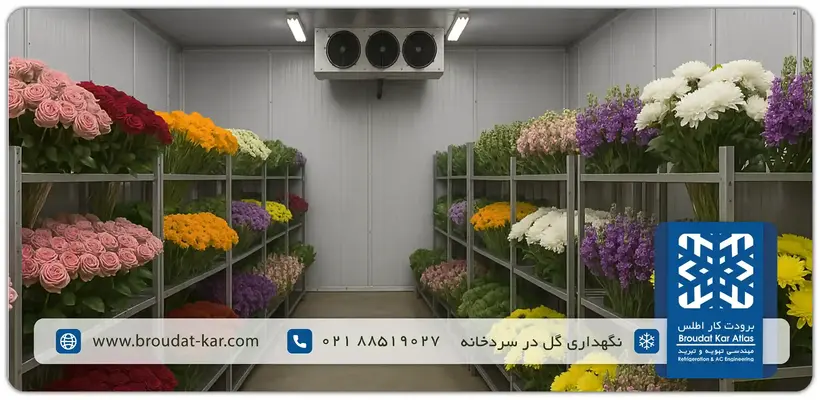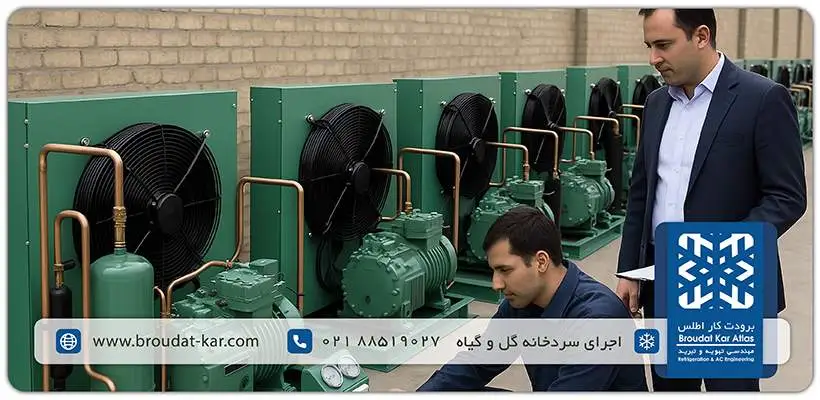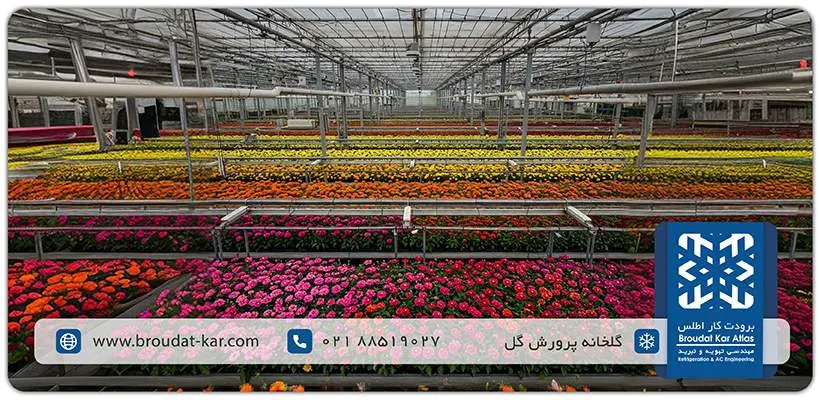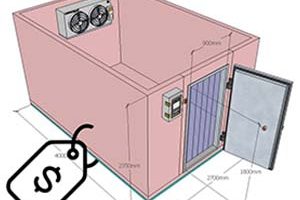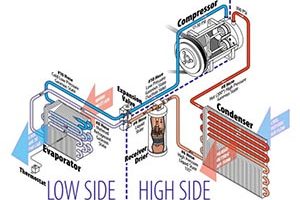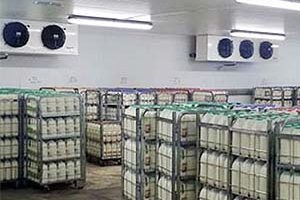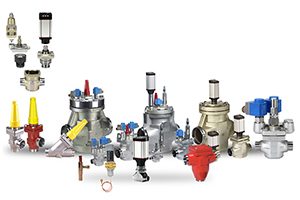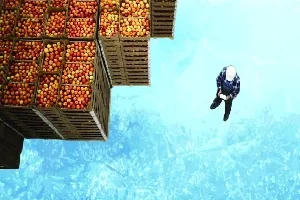Why do we need Flower & plant cold rooms?
Within the supply chain for flowers and plants, the use of dedicated cold storage is critically important. From the moment flowers are cut and prepared for shipment to florists until they reach the buyer, they must be kept in a cool, controlled environment above 0 °C with appropriate humidity. Otherwise, due to biological processes (such as the breakdown of sugars and starches in plant tissues to produce water, carbon dioxide, and energy), they wilt quickly and their vase life is shortened. That said, each type of plant must be stored under its own specific conditions.
Types of Flower and Plant Cold Storage
An important point is that by using above-freezing cold rooms, we can prevent—or at least delay—wilting and microbial spoilage in plants. Today, various types of cold rooms are designed and built, which are generally classified into above-zero cold rooms and sub-zero cold rooms.
Above-zero flower cold room
The appropriate temperature for flower cold storage is typically above 0 °C; therefore, above-freezing flower cold rooms are used for storing most flowers and plants. These facilities provide temperatures between 0 and 4 °C (near freezing). Of course, each type of flower and plant requires specific temperature and humidity conditions, but in general, this temperature range is suitable for most of them, as well as for many fruits, vegetables, and other plant materials.
At the same time, humidity and ventilation (air circulation) in above-freezing cold rooms must be fully controlled. For example, the best relative humidity range for storing flowers is 90–95%. For some plants, such as herbaceous plants, an RH of 80–85% is appropriate. Certain flowers may also require particular humidity levels—for instance, tulips should be held at a relative humidity of 70–75%, and some tropical flowers are best stored at around 10 °C with 60–85% RH.
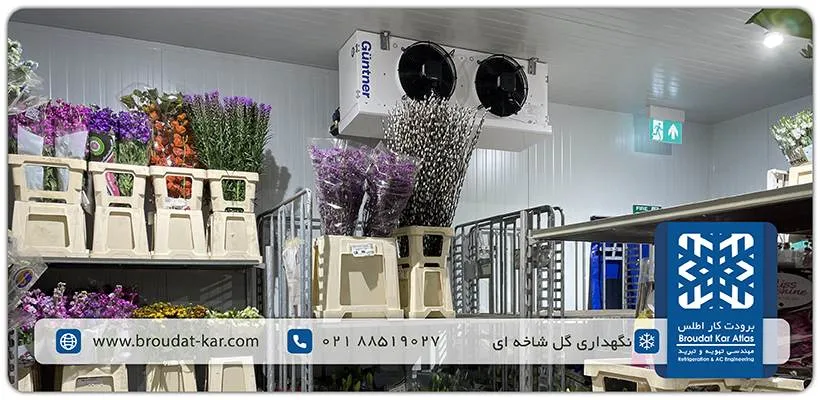
One category of plants with significant commercial importance is cut flowers. Storage conditions for cut flowers differ somewhat from those of other flowers and plants; for example, the storage temperature for cut flowers is typically set between 0 and 2 °C. The cold room’s relative humidity (RH) should also be maintained at approximately 90%.
In constructing cold storage for cut flowers, it is essential to create conditions that prevent the production and release of ethylene gas, as the emission of this gas by flowers (due to unfavorable environmental conditions)can accelerate the degradation of floral and plant tissues.If proper conditions are provided,flowers can remain fresh for up to one month.
| Special conditions | Relative humidity (%) | Suitable temperature (°C) | Type of flower or plant |
| Prevention of ethylene gas release | 90 | 0-2 | Cut branch flowers |
| Higher temperature to prevent chilling injury | 60-85 | 10-13 | Tropical flowers (Anthurium, Orchid, Bird of Paradise) |
| Adequate ventilation to prevent decay | 80-85 | 0-4 | Herbaceous plants |
| Precise humidity control to prevent mold growth | 85-95 | 0-4 | Chilling-sensitive fruits and vegetables |
Sub-zero flower cold room
As a rule, a sub-zero cold room is not used for storing flowers and plants, because the recommended storage temperatures for most flowers and plants are above 0 °C. The environment still needs to be cool; therefore, the cold room is controlled at temperatures close to 0 °C.
Advantages of Flower and Plant Cold Rooms
The benefits of storing flowers in a cold room include the following:
- Slowing the biological processes in plants and flowers.
- Preventing moisture loss and wilting in plants and flowers.
- Reducing ethylene production by keeping the cold room cool.
- Extending the lifespan of plants and flowers—especially cut flowers, which are of significant financial importance.
- Providing adequate windows for the export and transport of flowers and plants.
- Enabling increased flower production and revenue generation through export.
How to Store Flowers and Plants in a Cold Room
To store flowers and plants in a cold room, you must consider factors such as temperature, humidity, ventilation and air circulation, as well as light levels. Temperature and humidity conditions were discussed in the previous section; however, to achieve appropriate humidity, standard equipment such as misters, etc., should be used.
In addition, to ensure proper ventilation, the air-supply systems must be designed so that they establish effective airflow throughout the cold room. Moreover, to make sure the air reaches all parts of the cold room and all flowers, the flowers should be placed at suitable distances from one another (and also at a proper distance from the walls) and should not be stacked.
The light level in the flower cold room must also be controlled so that it does not cause wilting and premature aging. One factor that leads to this is excessive light; therefore, in a flower cold room—especially for cut flowers—we should aim to provide the lowest feasible level of illumination.
In general, two methods are used to store cut flowers: dry and wet. In the dry method, the flowers are kept in plastic (nylon) bags so they do not lose moisture. In the wet method, the flowers are placed in water.
Storing Flowers and Plants in a Cold Room for Export
Storing flowers and plants for export requires special conditions, because these products have high commercial value. If you plan to export flowers and plants, you must first consider issues such as the destination country’s sanitary and phytosanitary standards, as each country may have its own specific requirements for flower handling and storage. Phytosanitary conditions are, in essence, standardized measures for protecting plants against pests and harmful agents. In addition, you must ensure appropriate temperature and humidity conditions. All of these factors—together with proper packaging (for example, fiberboard and wooden boxes that are larger than the dimensions of the flowers)—help ensure that the flowers are exported without damage and at the highest level of quality.
Design and Construction of Cut-Flower Cold Rooms
In designing and constructing flower cold rooms, the appropriate storage conditions for flowers and plants must be carefully considered. Moreover, since each type of flower and plant must be kept in a cold room under specific conditions—and we cannot store all types of flowers, especially cut flowers, in a single cold-room model—cut-flower cold rooms are generally smaller in size. In general, the following steps are followed to set up a flower and plant cold room.
Request and Order for Cold Room Construction
At the first stage, you can obtain free, specialized consultation from the technical experts at Broudat Kar Atlas to order a cold room tailored to your needs. During this stage, a precise needs assessment is carried out in accordance with your business conditions. After that, you can submit an order to construct the cold room based on the capacity of the flowers.Cooling Load Calculation
The cold room’s cooling load must be calculated with precision to prevent unnecessary costs and energy waste. At this stage, Broudat Kar Atlas specialists determine the required cooling load according to the flower types, storage tonnage, and environmental conditions.Selection of Appropriate Equipment
One of the key steps in building and commissioning a flower cold room is using modern equipment from reputable brands. Among the most important equipment are the compressor, evaporator, humidification systems such as misters, and the electrical and air-circulation systems.
- Technical Proposal and Budget Review
After the appropriate equipment has been identified, a technical proposal—based on your budget and an itemized list of foreseeable costs—will be presented. You can then make decisions in line with your budget. Site Visit
At this stage, the installation site for the cold room is inspected. This is done to evaluate the physical conditions, cold-room dimensions, and available utilities so the system can be implemented more effectively and optimally.Contract Signing
Here, a contract is concluded between you and the Broudat Kar Atlas team. The contract will specify all project details, the construction process, the budget, and the project completion timeline.Cold Room Installation and Standard Execution
Following the contract, the installation and execution of the cold room begin. During this phase, the appropriate equipment is procured and installed.Warranty and Support
After installing the flower and plant cold room, Broudat Kar Atlas provides after-sales service and technical support. In addition, all of the company’s equipment carries a one-year warranty.
Price of Cut-Flower Cold Rooms
The price of flower and plant cold rooms depends on various factors; one of these is the required tonnage and capacity. In addition, the cold room’s dimensions, the type of equipment used, and so on also affect the total cost and price. To estimate costs and pricing for a cold room, you can refer here.
Purchasing Flower & Plant Cold Rooms
When purchasing a cold room for cut flowers and other flower/plant applications, you should consider the manufacturer’s profile and level of experience. Failure to follow standards by some companies ultimately leads to extra costs and damage to the flowers. In addition, before buying a flower/plant cold room, it is advisable to review the unit’s features and the appropriate standards for flower storage.
Broudat Kar Atlas Services for Flower & Plant Cold Rooms
As one of the leading producers of various flower and plant cold rooms in Iran, Broudat Kar Atlas uses state-of-the-art, advanced equipment for construction—such as top-tier compressors (well-known brands like Danfoss, Bitzer, etc.), sandwich panels, XPS insulation, and more. All equipment provided by the company carries a one-year warranty, and you can benefit from ongoing support after purchase as well.
Why Broudat Kar Atlas?
Fully competitive, reasonable pricing
Experienced technical team and professional support
Proper installation and commissioning in line with current standards
Use of reputable brands
Fast installation and execution
Final Word on Cut-Flower Cold Rooms
In the end, it can be said that building a cold room for cut flowers—and for other types of plants—requires close attention to key standards. Otherwise, storage will not only fail to extend the lifespan of the flowers, it can actually accelerate deterioration. If you are looking to purchase a suitable greenhouse/flower cold room, you can take advantage of Broudat Kar Atlas’s free consultation starting now. To get started, contact our specialists through the communication channels listed on the website.
Each flower has its own specific temperature and humidity requirements. Therefore, if possible, it’s best to provide storage conditions tailored to each type of flower. Otherwise, choose conditions that are suitable for the greatest number of flowers.
To reduce and deactivate ethylene gas, substances such as silver thiosulfate (STS) and Ethyl Block can be used. These agents help preserve the freshness of flowers.
The ideal relative humidity for storing flowers is 90–95%. However, some flowers require lower humidity; for example, tulips and tuberose are best kept at 70–75% RH.
Related posts
Flower & plant cold rooms
Cold Room Price Estimation – Year 2024 At Atlas Refrigeration, we recognize the pivotal role cold rooms play in diverse
Cold Storage Equipment Cold storage equipment encompasses a variety of machines and devices specifically designed to store perishable goods at
What is Industrial Cold store? An industrial cold store is a large-scale facility designed and constructed to preserve and
Valves and Control Devices in Ammonia and Freon Refrigeration Systems The variety of valves and control devices in refrigeration systems
What is Fruit Cold Storage? A Fruit cold storage is a specialized facility designed to store fruits and vegetables
